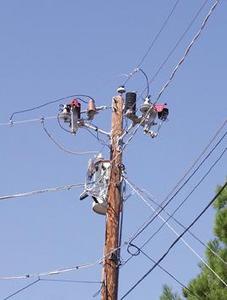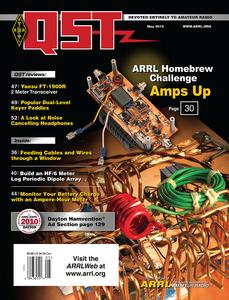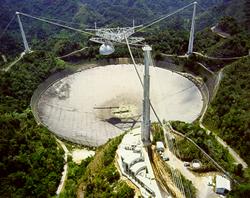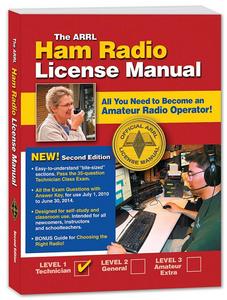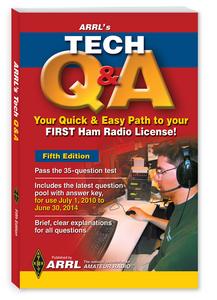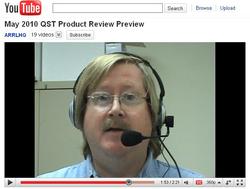 April 8, 2010 John E. Ross, KD8IDJ, Editor
| ||||||||||||||
BPL: City of Manassas to End BPL Service
Once touted as "the most successful BPL deployment in the nation," the City of Manassas has decided to get out of the BPL business, once and for all. At a Special Meeting on Monday, April 5, the Manassas City Council -- acting on a recommendation from the Manassas Utilities Commission -- unanimously voted to discontinue Broadband over Powerline (BPL) Internet service as of July 1, 2010 to the approximately 520 residents and businesses who currently subscribe to the service; these customers were told that they have three months to find a new Internet service provider. According to Manassas City Clerk Andrea Madden, there was no discussion on the resolution to discontinue service and the motion was passed "without incident." With the motion made by Councilman Jonathan Way and seconded by Mark Wolfe, the City Council cited three reasons for discontinuing BPL service: a declining customer base, an annual income deficit of almost $166,000 from providing Internet service, and a determination that AMI [Advanced Metering Infrastructure] platforms don't require BPL. Way and Wolfe favored shutting down the BPL system in November 2009, the last time this matter was brought to the Council's attention. "The City needs to get out of BPL forthwith," Way said back in 2009. "It's not a good product. The whole business is not financially sound and it never has been." Manassas residents pay $24.95 each month to receive Internet service via BPL. In November 2009, the Utility Commission showed the Council that little more than 500 residents and 46 businesses currently subscribed to the service, which since 2008, has been run by the City. "It's costing a little more to maintain the system than we projected in the budget," Manassas Director of Utilities Michael Moon told the Council. "The original projections were that the customer base would be double this." In September 2008, the Manassas City Council voted to assume control of the BPL service from COMTek, the private company that served (back then) approximately 675 residents. In January 2009, there were 637 residential and 51 commercial BPL subscribers in Manassas. In February 2010, those numbers had shrunk to 457 residential and 50 commercial subscribers. The Utilities Commission said that the total revenue brought in by BPL for FY2010 was almost $186,000, but the expense of keeping up the City-owned system was costing the ratepayers a little more than $351,000, resulting in a net loss of almost $166,000. "In October 2003, the Manassas City Council was told that it could expect as much as $4.5 million in revenue from awarding a 10 year BPL franchise," said ARRL Chief Executive Officer David Sumner, K1ZZ. "Instead, six months later, BPL had turned into a money pit for the City of Manassas. Anyone thinking of investing in BPL would do well to learn from the Manassas experience."
In November 2009, Manassas' Assistant Utilities Director (Electric) Gregg Paulson told the ARRL that they had "every intention of putting BPL Internet service in the budget and the Council can decide its fate as they work through the budget process." Paulson also said that while Internet service to consumers would "probably" be the only thing that would be cut if the Council decided to forego BPL, he left the door open as to using the BPL infrastructure for other purposes: "We still own the BPL network, but we may or may not use this network for utility monitoring or other AMI purposes." But according to the resolution passed by the Council, the Manassas Utilities Department will not be using BPL for AMI, but instead will use "a combination of fiber and wireless technology exclusive of the BPL." According to the Agenda Statement for the Special Meeting, the BPL equipment will be removed from the system and "inquiries will be made regarding the salvage value." Sumner said that the ARRL's concern was not with the business plan -- that he termed "obviously flawed" -- but with "the interference to licensed radio services -- and in particular the Amateur Radio Service -- inevitably caused by putting radio frequency energy on unshielded, unbalanced conductors. Manassas was touted as 'the most successful BPL deployment in the nation' when FCC Chairman Michael Powell visited the site with much fanfare -- and, the ARRL maintains, in violation of the FCC's own rules -- on the eve of the FCC's vote to adopt inadequate protection for licensed radio services against interference from BPL systems. The taxpayers and ratepayers of Manassas are not the only ones who benefit from the end of this ill-considered foray into BPL. Radio amateurs in the Manassas area have good reason to celebrate, for they have spent countless hours documenting the widespread interference caused by the system." BPL technology uses the electricity grid in a city and the wiring in individual homes to provide direct "plug in" broadband access through electricity sockets, rather than over phone or cable TV lines. Because BPL wiring is physically large, is often overhead and extends across entire communities, these systems pose a significant interference potential to over-the-air radio services, including Amateur Radio. FCC News: ARRL Responds to FCC's NPRM Calling for New Rules on Vanity and Club Call Signs
In November 2009, the FCC issued a Notice of Proposed Rule Making (NPRM) -- WT Docket No 09-209 -- seeking to amend the Commission's Amateur Radio Service rules in an attempt to clarify certain rules and codify existing procedures governing the vanity call sign system, as well as revise certain rules applicable to club stations. In March, the ARRL submitted comments and additional proposals to the FCC to update the Amateur Service's call sign assignment system and provide for continued growth of the Amateur Radio Service, as well as enhance the pride and satisfaction of licensees in their personal achievements in the radio art. The ARRL's positions were developed by the Executive Committee at its March 13 meeting. Read more here. FCC News: ARRL Files Comments in Response to Hospital Association Seeking Blanket Waiver Request for Amateur Radio Drills
In February 2010, the American Hospital Association (AHA) filed a request with the FCC for a blanket waiver of Section 97.113(a)(3) of the Commission's Rules "to permit hospitals seeking accreditation to use Amateur Radio operators who are hospital employees to transmit communications on behalf of the hospital as part of emergency preparedness drills." On March 3, the FCC issued a Public Notice -- WP Docket 10-54 -- asking whether the Commission "should grant AHA's request for a blanket waiver of Section 97.113(a)(3) to permit amateur operators who are hospital employees to participate in emergency drills that are conducted by hospitals for accreditation purposes and that are not government-sponsored." Section 97.113(a)(3) specifically prohibits amateur stations from transmitting communications "in which the station licensee or control operator has a pecuniary interest, including communications on behalf of an employer." On April 2, the ARRL filed comments regarding the blanket waiver request. Read more here. FCC News: ARRL Files Petition for Reconsideration over Waiver for Non-Amateur Device in 70 cm Band
In January 2008, a company called ReconRobotics filed a request with the FCC for a waiver of Part 90 of the Commission's Rules with respect to the Recon Scout -- a remote-controlled, maneuverable surveillance robot designed for use in areas that may be too hazardous for human entry. A waiver is required to permit licensing of the Recon Scout because the device operates in the 430-448 MHz band, which is allocated to the Federal Government Radiolocation service on a primary basis, as well as the Amateur Radio Service and certain non-federal radiolocation systems on a secondary basis. More than two years later, the FCC granted the waiver request in the form of an Order (WP Docket No 08-63), subject to certain conditions. The ARRL had opposed the waiver on the grounds that the device has a significant potential to interfere with amateur stations and that the company is simply trying to avoid redesigning for the domestic market a device that was designed for military use overseas, and as such, filed a Petition of Reconsideration with the FCC in late March. Read more here. Public Service: Telephone Outage in Nebraska Was No April Fool's Joke Early on the morning of April 1, almost 40,000 people in Southeastern Nebraska -- including the City of Lincoln's government, business and emergency centers -- found that they had no landline telephone service, as well as spotty cell phone coverage, thanks to an equipment malfunction at a Lincoln switching facility owned by Windstream Communications. According to news reports, residents of 12 counties were unable to contact 911 and dispatch centers had rely on other communications services -- including Amateur Radio. Read more here. On the Air: The First Rookie Roundup -- Coming April 18!
The ARRL's newest contest -- the Rookie Roundup -- is getting a lot of buzz among newly-licensed amateurs. Designed as a modern equivalent to the ARRL Novice Roundup from a few decades ago, this new incarnation combines a competitive event with some on-the-air training. The first Rookie Roundup is scheduled for April 18 and will be an SSB contest. The Rookie Roundup is six hours of fun on a Sunday afternoon that is designed to give new hams a chance to get their feet wet on HF and 6 meters. Old-timers are encouraged to get on the air and work the Rookies, just as in they did in the Novice Roundups. The six hour event -- from 1800 UTC-2359 UTC -- will be held on the third Sunday of April, August, and December. SSB, RTTY, and CW will be featured in the different months. Read more here. Coming Up in QST : Check Out What's in the May Issue
The May issue of QST is jam-packed with all sorts of things today's Amateur Radio operator needs. From product reviews to experiments to contesting -- including a breakdown of the Second ARRL Homebrew Challenge -- the upcoming issue of QST has something for just about everyone. You'll find an abundance of technical and general interest articles, as well as monthly columns such as Happenings, How's DX, Hamspeak, Vintage Radio and more. Click here to discover what's in store for you in the May issue of QST, the official journal of the ARRL. On the Air: Moonbounce for Everyone -- Courtesy of the Arecibo Radio Telescope!
Sending Amateur Radio signals to the Moon and back has never been easy. After roundtrip journeys of nearly half a million miles, even the most powerful signals generated by hams are exquisitely weak on arrival. Because of the equipment and expertise necessary for successful "moonbounce" operating, this facet of Amateur Radio generally has been confined to a small audience. But for three days in April even hams with very modest stations will have the opportunity to experience the thrill of moonbounce, thanks to the giant radio telescope at the Arecibo Observatory in Puerto Rico. Read more here. Solar Update
Tad "Pay no worship to the garish Sun" Cook, K7RA, reports: A strong solar wind blasted us on Monday and Tuesday, causing the biggest geomagnetic storm since 2006. On those days, the mid-latitude A index was 28 and 22 and the planetary A index was 49 and 46. A search for similar numbers over the past few years yields nothing. In 2009, the highest planetary A index was 19 on August 30, and in 2008 it was 37 on October 11. This is indicative of how quiet space weather has become in the past few years. In 2007, the planetary A index reached 30 on April 1, and we have to go back to 2006 to find any geomagnetic activity as strong, when the planetary A index reached 63 and 104 on December 14-15. It seems counter-intuitive, but average daily sunspot numbers rose by 3.5 points this week to 32.4, while the average daily solar flux dropped more than 7 points to 77.8. NOAA and USAF predict solar flux at 76 for April 8-9, 75 on April 10-14 and a jump to 80 on April 15. The same forecast predicts planetary A index settling down to 15, 8, and 5 for April 8-10. For some reason, despite the high geomagnetic activity, no reports have come in from 6 meter operators about auroral propagation. Perhaps we will hear from them before Friday when this week's bulletin is released. Look for more information on the ARRL Web site on Friday, April 9. For more information concerning radio propagation, visit the ARRL Technical Information Service Propagation page. This week's "Tad Cookism" brought to you by William Shakespeare's Romeo and Juliet (Act III, Scene 2). ARRL Publications: New Editions of the ARRL Ham Radio License Manual, Tech Q&A Now Available
Discover all the excitement of Amateur Radio when you get your Technician license -- your ticket to the unique mix of fun, public service, technology and experimenting with electronics. The ARRL Ham Radio License Manual and ARRL's Tech Q&A will guide you as you get started in Amateur Radio, helping you select your equipment, set up your first station and make your first (of many!) contacts. These manuals -- designed for Technician exams given after July 1, 2010 -- contain all of the information you need to study for and pass the 35 exam questions derived from the new
Technician class (Element 2) question pool. The questions in the pool provide for the new Technician licensee to be able to establish his or her station and operate it legally, courteously and safely. The new Technician pool contains approximately 400 questions, from which 35 are selected for an Element 2 examination; the exam will contain graphics and diagrams. When you use The ARRL Ham Radio License Manual and the ARRL's Tech Q&A to study for your first license exam, you'll be on the air in no time! Every page presents information you will need to pass the exam and become an effective operator, such as radio and electronics fundamentals, operating station equipment, communicating with other hams, licensing regulations, operating regulations and radio safety. Read more here. This Week on the Radio
This week, the Montana QSO Party is April 9-11. The Japan International DX Contest, the QCWA Spring QSO and the Georgia QSO Party are April 10-11. Next week, the TARA Skirmish Digital Prefix Contest, the Holyland DX Contest and the EU Spring Sprint are April 17. The Michigan QSO Party, the Ontario QSO Party and the YU DX Contest are April 17-18. The Run for the Bacon QRP Contest is April 19. All dates, unless otherwise stated, are UTC. See the ARRL Contest Branch page, the ARRL Contest Update and the WA7BNM Contest Calendar for more info. Looking for a Special Event station? Be sure to check out the ARRL Special Event Station Web page. ARRL Continuing Education Course Registration
Registration remains open through Sunday, April 25, 2010, for these online course sessions beginning on Friday, May 7, 2010: Amateur Radio Emergency Communications Level 1; Antenna Modeling; Radio Frequency Interference; Antenna Design and Construction; Propagation; Analog Electronics, and Digital Electronics. To learn more, visit the CEP Course Listing page or contact the Continuing Education Program Coordinator. | ||||||||||||||

